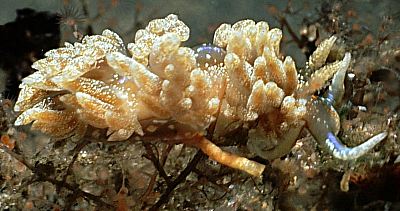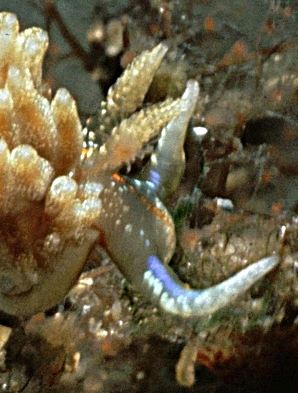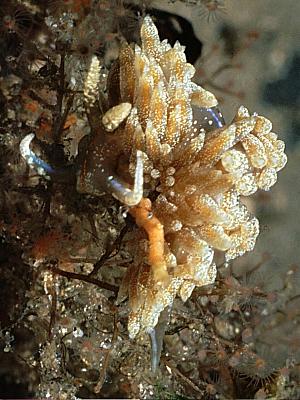Mystery aeolid from Florida
September 20, 2002
From: Anne DuPont

Dear Bill,
We found this nudibranch last Saturday night, September 7, 2002, West Palm Beach, Florida, in 12 feet of water on a night dive.
It was on the same hydroids that we find the Dondice occidentalis feeding on. Can you identify this nudibranch?
Thank you again for all your help.
Cordially,
Anne DuPont
Delray Beach, Fl, USA.
akdupont@bellsouth.net


Dear Anne,
There is a possibility it is a form of Dondice occidentalis. It has an orange median line on the head and another on each side of the head, and a median white line on the dorsum behind the rhinophores, which are all features of some specimens of D. occidentalis. However from my interpretation of your photos the rhinophores are not lamellate, as occurs in D. occidentalis, but tuberculate.
I thought the tuberculate rhinophores might give me a clue but they lead me to a number of poorly described names. I wish people would realise how important a good description of the external animal is when describing species.
Caribbean species with tuberculate rhinophores;
• Facelina agari Smallwood, 1910 : brown with white spots on cerata and body
• Berghia creutzbergi Marcus & Marcus, 1970 : brown with white spots on cerata and body
• Berghia benteva (Marcus, 1958) : translucent white with white browns spots on cerata
• Moridilla kristenseni Marcus, 1963 : light yellow with silvery white net and black stipples on cerata
• Palisa papillata Edmunds, 1964 : body silvery gray... whole of dorsal surface including cerata.. covered with a network of fine white lines.... digestive gland duct in cerata pale buffish with dark brown spots.
Only Edmunds' original description gives adequate information on the living animal. Facelina agari [F. Glaucidae] and Berghia creutzbergi [F. Aeolidiidae] have white spots like your animal. I suspect your animal is likely to be a glaucid, since it is on hydroids, so I guess that excuses B. creutzbergi. It could be Facelina agari, but there is really no way of knowing just what Smallwood's description refers to.
Distinguishing features of your species seem to be the the red-orange median line on the head, a similar line on each side of the head, the white spots, the blue line on the oral; tentacles and the papillate rhinophores. I don't think this species has been described before, but it really depends on whether the rhinophores are lamellate or tuberculate [papillate].
Best wishes,
Bill Rudman
Related messages
-
Re: Dondice occidentalis from Massachusetts?
From: Emily Keen, March 18, 2010 -
Dondice occidentalis from Massachusetts?
From: Emily Keen, February 22, 2010 -
Dondice occidentalis from North Carolina
From: Marcel Tanke, October 1, 2009 -
Dondice occidentalis defensive behavior
From: Tony Fernando, November 23, 2006 -
Dondice occidentalis from Florida
From: Jeff Goddard, May 7, 2005 -
Re: Dondice occidentalis feeding
From: Marina Poddubetskaia, March 23, 2004 -
Dondice occidentalis from Bahamas
From: Marina Poddubetskaia, March 22, 2004 -
Dondice occidentalis feeding
From: Marina Poddubetskaia , March 22, 2004 -
Dondice occidentalis from Southern Bahamas
From: Anne DuPont, November 25, 2003 -
Dondice occidentalis with eggs
From: Anne DuPont, November 25, 2003 -
Dondice occidentalis? from Jamaica
From: Ross W. Gundersen, October 20, 2003 -
Re: Mystery aeolid from Florida
From: Anne DuPont , September 27, 2002 -
Dondice occidentalis from Florida
From: Anne DuPont, August 1, 2001 -
Dondice cf. occidentalis from Brasil
From: Carlo Magenta-da-Cunha, June 12, 2000 -
Re: Dondice occidentalis from Belize
From: Carlo Magenta-da-Cunha, June 9, 2000 -
Dondice occidentalis from Belize
From: Dave Behrens, November 10, 1999 -
Re: Dondice occidentalis from Colombia
From: Phanor Montoya , October 23, 1999 -
Dondice occidentalis from Colombia
From: Phanor Montoya, October 21, 1999
